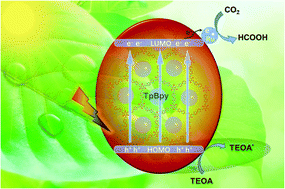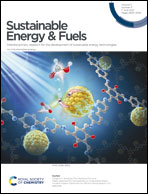Highly dispersed Ru nanoparticles on a bipyridine-linked covalent organic framework for efficient photocatalytic CO2 reduction†
Abstract
The visible-light driven photocatalytic conversion of CO2 into valuable hydrocarbons is a highly attractive approach for sustainable carbon cycle to solve the worldwide environmental and energy problems. Herein, highly dispersed Ru nanoparticles (NPs) are confined in a photosensitizing bipyridine-linked covalent organic framework (TpBpy) to facilely construct Ru@TpBpy composites. The resulting Ru@TpBpy catalysts exhibit significantly enhanced activities for CO2 reduction under visible-light irradiation, giving the maximum HCOOH production rate of 172 μmol gcat−1 h−1 over 0.7 wt% Ru@TpBpy. The interactions between Ru NPs and TpBpy can not only enhance the visible-light harvesting, but also restrain the recombination of photo-generated charges efficiently and facilitate the electron transfer through Ru NPs, thereby improving the photocatalytic performance for CO2 reduction. The current work provides a promising pathway to construct efficient photocatalysts with highly dispersed metallic NPs confined into photosensitizing COFs via utilizing the coordination microenvironments and also expands the application of COF-based materials.



 Please wait while we load your content...
Please wait while we load your content...